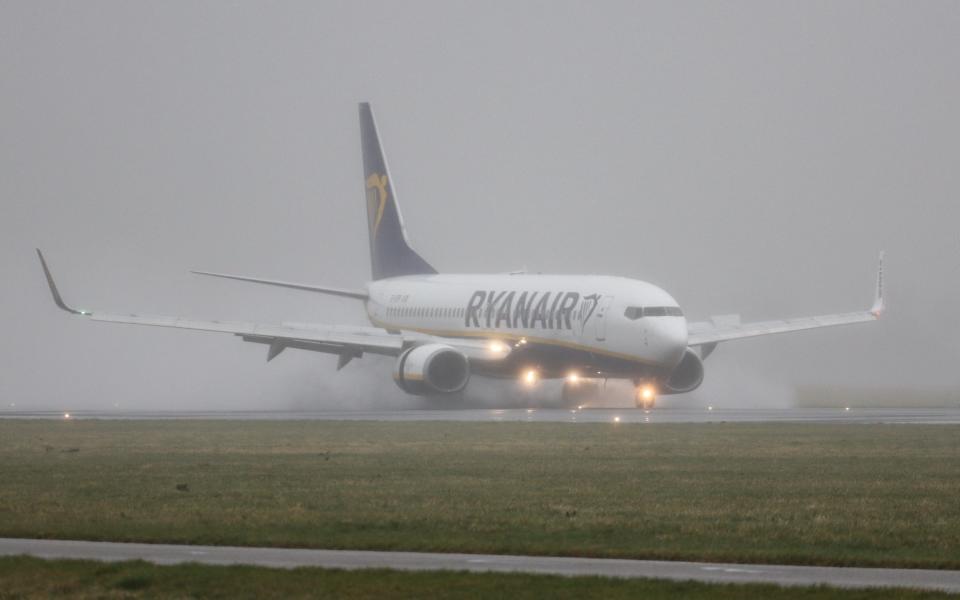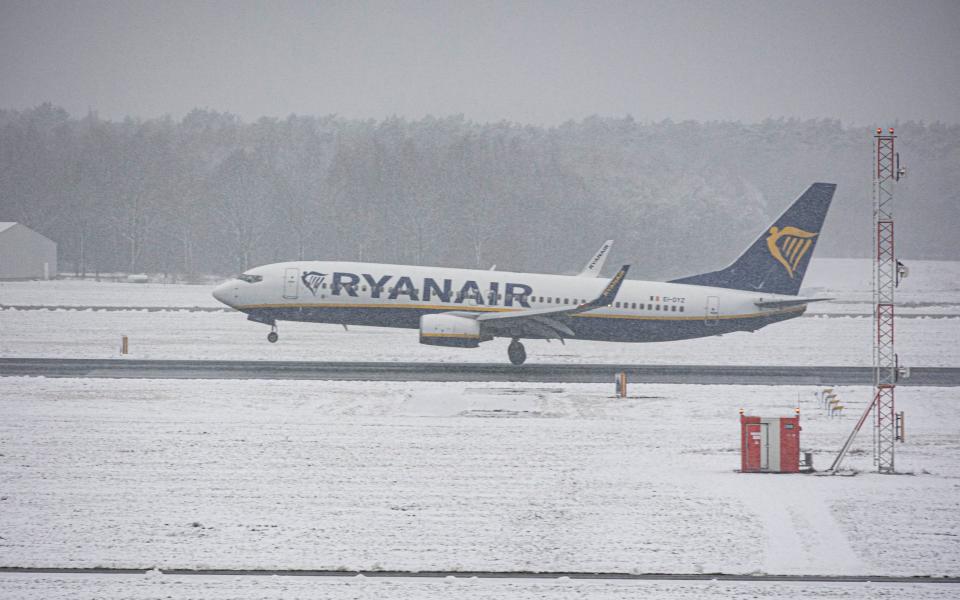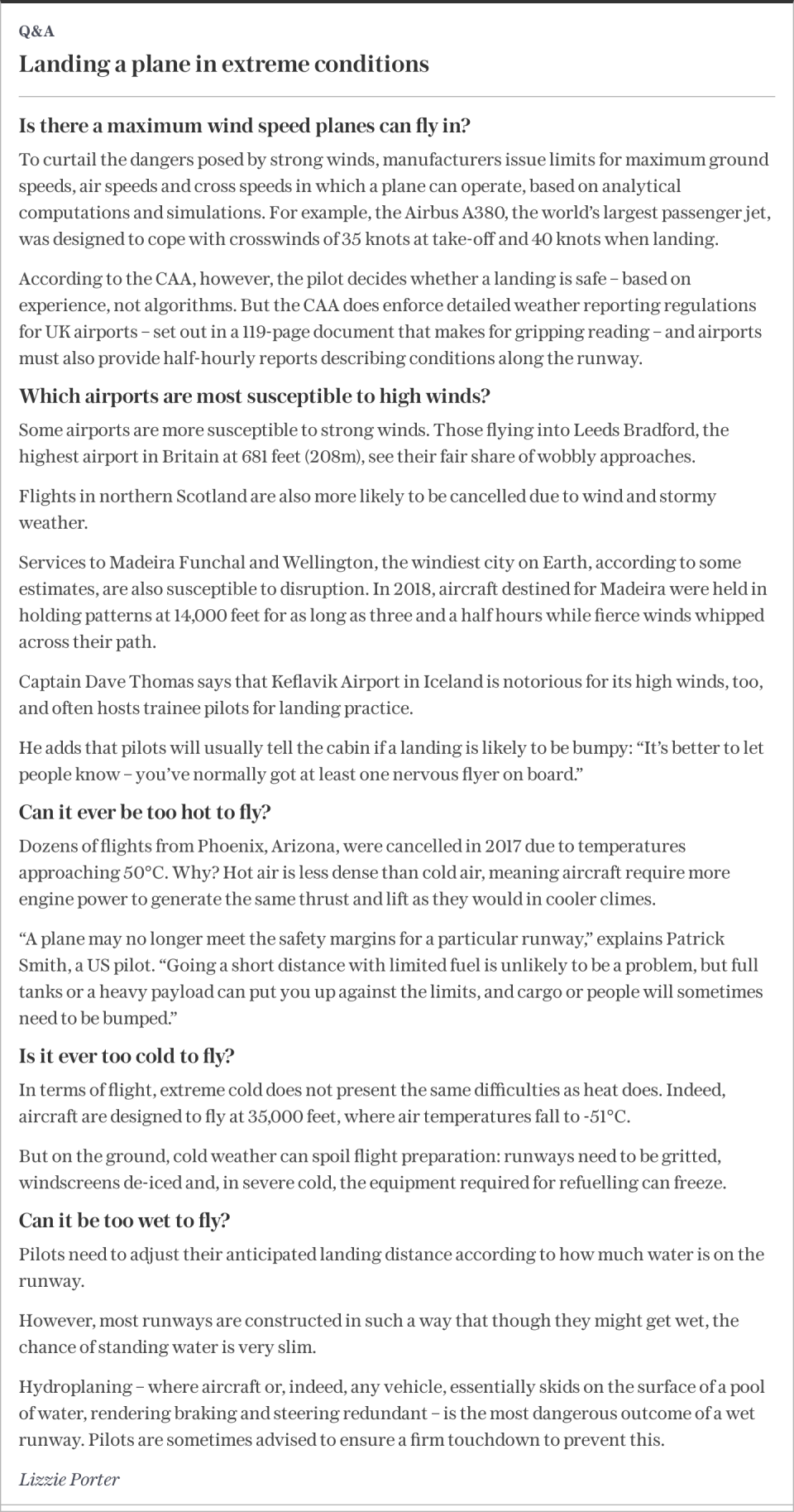If you fly before Christmas, it can be a bumpy journey. Hundreds of flights across Europe have been canceled due to Storm Pia, with airline KLM alone grounding more than 200 flights and British Airways suspending 24 of its routes. The disruption is expected to last until at least 9pm on Thursday.
The Met Office issued a yellow weather warning on Wednesday, warning of winds of up to 80mph and heavy rain, potentially affecting airports in northern England, the Midlands, Wales, Scotland and Northern Ireland. Meanwhile, Schiphol Airport has warned that “a significant number of flights will be delayed or canceled” on Thursday and Friday.
Landing or taking off in high winds is never fun as a passenger – but while we squirm, what about the captain and first officer at the helm of the plane? What processes do they have to follow to keep us safe – and do they ever turn green around the gills? From fuel consumption calculations to the “adrenaline” of missed landings: this is what goes on in the cockpit…
1. Aim ‘upwind’ when landing
First things first. Shaky “sideways” landings shouldn’t alarm anyone. Pilots are even trained to perform this exact maneuver in strong crosswinds.
Patrick Smith, an American pilot and author of Cockpit Confidential, explains that proper landing technique is “a slightly askew alignment, with one set of tires touching the ground before the other.”
Mark Vanhoenacker, Senior First Officer of British Airways, agrees: “When a plane lands in a crosswind, pilots typically point the plane into the wind, a maneuver that causes the plane to move along the ground straight toward the runway.” , he says. say. “This technique is effective but challenging.”
That’s why it takes some practice. BA trains its pilots every six months to land in strong winds. Captain Dave Thomas, the airline’s head of flight engineering and training, said the difficulty of landing in high winds depends on both wind speed and direction.


In an ideal world, the pilot wants to land into the wind and in the middle of the runway. If there is a difficult crosswind, he adds, they will approach with the plane’s nose pointed into the wind. Just as the pilot performs the “flare” – intended to slow the rate of descent – he or she will align the nose of the plane with the runway.
If this maneuver is performed too early, “the aircraft will not land in the center of the runway – or on the runway at all,” Thomas says. If the pilot is not satisfied with the first attempt, he or she will abort the landing and try again. In what is known as a “retracted landing,” the plane may even hit the runway first.
In the windiest conditions, a “wingstrike” can occur – when, you guessed it, a wing hits the runway during landing. It doesn’t happen often, although one notable incident occurred in 2008, when a Lufthansa A320 attempted to land at Hamburg Airport amid wind gusts of up to 47 knots (54 mph). The footage on YouTube is excruciating, but no one was injured and the plane eventually landed on a different runway.
2. Beware of ‘wind shear’
The phenomenon known as “wind shear” also poses a risk. This is a sudden change in wind speed and/or direction, causing turbulence or a rapid increase or decrease in speed. A tricky scenario could be a pilot trying to land with a headwind that suddenly turns into a tailwind. The result? Land late and quickly, and possibly overrun the runway, our experts say.
According to Airbus, wind shear is the main cause of 4 percent of ‘approach and landing’ accidents: a small percentage, but enough to justify avoiding action. Captain Thomas says wind shear can cause a pilot to call off a landing as the plane approaches the runway: “It’s the right thing to do: turn on the power and get up and go.”
3. If you can’t land, move around – and try again
If they are not satisfied with the landing conditions, pilots will choose to “go around” – essentially abandoning the descent, taking off again and trying again.
“In storms this may be related to turbulence, wind shear or fluctuating wind conditions, reduced visibility during rain showers, or [if] the pilot is just not happy with the position of the aircraft on the runway,” says a training captain flying the Boeing 787 for a major British airline, who has 27 years of experience.
“The decision is made by one of the operational pilots at the controls, as they are the only ones who can assess the safety of the aircraft. The safety of our passengers and the aircraft is always our top priority.
The decision will come very soon, our anonymous pilot warns. “It is unlikely that there will be a warning for passengers. When the decision has been made, a ‘Go-around’ call is made by one of the pilots. The pilot flying the aircraft presses one of the ‘TO/GA’ (TakeOff / Go-Around) switches mounted behind the throttles. This generates a large and rapid increase in thrust, raising the nose of the aircraft in most cases, and also generates ‘fly-up’ guidance on the primary flight display to help the pilot fly away from the ground.
“The passengers will feel the aircraft rising rapidly and will be pushed back into their seats as the aircraft accelerates rapidly away from the ground. A go-around can take place after landing, but the aircraft can also land during the go-around maneuver. In these cases it is always safer to continue the go-around than to attempt to land in unsafe conditions.”
The pilots then follow air traffic control instructions to place them in the approaching aircraft streams for another landing attempt, if necessary, or divert to another airport with better conditions. “The minutes immediately after a go-around are always busy as the crew assesses the weather, remaining fuel and talks to air traffic control – so it may take a few minutes before they can talk to the passengers, so please don’t feel like we’re ignoring you .”
What’s the atmosphere in the cockpit as passengers grip their seats? “Flying a go-around always generates a physiological response in the sense that you get a rush of adrenaline, but the maneuver is practiced literally hundreds of times in the simulator by every commercial pilot and is checked by an examiner every six months,” says our training captain . “Although it is quite an exciting maneuver to fly – [and] relatively rare – the crews are well trained to remain calm all the time.”
Do they ever get motion sick? “I don’t remember ever seeing a motion-sick pilot in the cockpit. Most of the time we concentrate too hard to have time to worry about things like that!”
4. Take a longer flight time into account
“Flying in strong headwinds can take a much longer flight time, [so] you have to calculate fuel consumption,” says commercial helicopter pilot Neil Conley, director at leading airlift consultancy Skytrail. “Normally in training you don’t fly when the wind is stronger than 25 knots – but I did my commercial license exam in 40+ knots. It was a terrible experience.”


As you might expect, flying a helicopter in bad weather comes with its own challenges – and sometimes it’s simply not possible. “In high winds, turning the helicopter while hovering can be very dangerous,” Conley said. “Because helicopters don’t normally have runways, it’s all about the landing area. A lot more planning goes into takeoff and landing when it’s windy.
“Just like airplanes, helicopters want and need to take off and land against the wind. If it is very windy, taking off/landing downwind takes a lot of force and is sometimes not possible. However, during flight it is not that dangerous [it] still requires a lot more planning.”
5. Embrace ‘plan B’ – and use it again to your advantage
“Even the most seasoned pilots sometimes have to admit defeat and swerve when conditions are just too bad,” says Jerry Dyer, founder of Big Jet TV, a YouTube channel that covers the action on the runways at major airports. Britain is streaming live – often wearing jeans. biting watch during storms. “These jets are filled with enough fuel to allow for all unforeseen circumstances, such as diversions. It is sometimes frightening for the passenger, but in the front it is all calm and under control.”
Airlines always have a plan B if the intended approach is not safe, or if the airport closes due to high winds. For example, flights wanting to land at an airport in London could be diverted to a British airport further north, or to an airport in Western Europe.
And if you’re lucky, the strong winds can even ensure that your holiday starts earlier. Strong tailwinds – and jet streams – can shave hours off a flight time. That fact made a BA flight almost supersonic in 2015: flying from New York to London in just five hours and sixteen minutes, compared to the usual travel time of almost seven hours.
Similarly, Qantas’ London-Perth service has occasionally cut its journey times by taking advantage of strong northerly winter winds, cutting time in the air from 17 hours and 20 minutes to almost 16 minutes.

